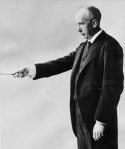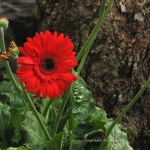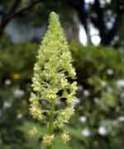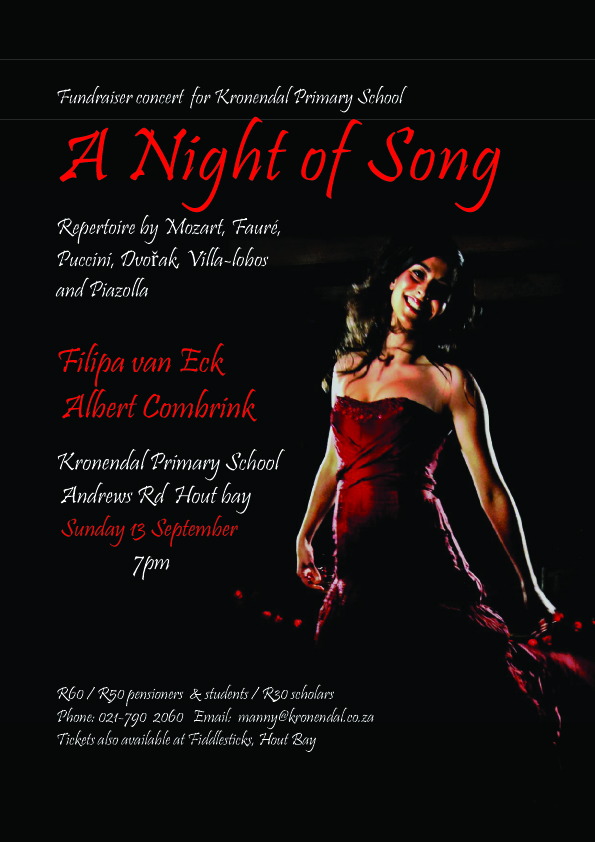
“Allerseelen” op.10 no. 8 (Text by Hermann von Gilm zu Rosenegg (1812-1864)
Published in 1885 when Strauss was 21, but possibly written when he was as young as 18, this song forms part of an extra-ordinary set of songs mostly written by a man still in his teens.
“Allerseelen” aus “Letzte Blätter” – with free translation by Albert Combrink
Stell auf den Tisch die duftenden Reseden. Die letzten roten Astern trag herbei. Und laß uns wieder von der Liebe reden. Wie einst im Mai. – Place on the table, the fragrant heather. The last red Asters, draw them near. And let us again talk of love. As once in May.
Gib mir die Hand, daß ich sie heimlich drücke, Und wenn man’s sieht, mir ist es einerlei, Gib mir nur einen deiner süßen Blicke, Wie einst im Mai. – Give me your hand that I can give it a secret squeeze. And if anyone saw it, to me it would be neither here nor there. Just give me one of your sweet gazes. As once in May.
Es blüht und [funkelt] dufted heut auf jedem Grabe. Ein Tag im Jahr ist ja den Toten frei. Komm an mein Herz, daß ich dich wieder habe. Wie einst im Mai. – Today each grave blossoms and gives off fragrance. One day in the year the dead are free. Come to my heart, that I may have you again. As once in May.
“Allerseelen” – Some textual considerations:
When writing his operas, Strauss demanded the highest quality from librettists. His working relationship with Hugo von Hofmannsthal (1874-1929) is well-documented. Hofmannsthal and Strauss had debates, arguments, philosophical discussions and volumes of correspondence, revealing much about the way in which Strauss crafted the music to suit the drama. And in many cases, vice versa. Hofmannsthal wrote libretti for several of his operas, including Elektra (1909), Der Rosenkavalier (1911), Ariadne auf Naxos (1912, rev. 1916), Die Frau ohne Schatten (1919), Die ägyptische Helena (1927), and Arabella (1933). Yet in each case, the composer had a hand in the making of the text. “Strauss the song-maker” had a very different approach. Strauss found pre-made texts, often of variable quality. Austrian civil servant Hermann von Gilm zu Rosenegg (1812-1864) is today mainly remembered for his poetry set by Strauss – Zueignung Op.10 No.1 and Die Nacht Op.10 No.3 being the other famous examples.
1. Religious context
The poet uses the context of a religious ceremony to express a deep love and passion, tapping into sub-conscious depths of feeling that transcends mere romantic love. This is an ancient ceremony, both mythical and mystical. The dead are remembered by their loved ones with flowers and candles on their graves. Sometimes the dead are even invited to participate in meals, with dishes set out for them on the family table. “Allerseelen” or “All Soul’s Day” (sometimes called the “Day of the Dead”) always falls on November 2 (November 3rd if the 2nd falls on a Sunday). It is a Roman Catholic day of remembrance for friends and loved ones who have passed away. This comes from the ancient Pagan Festival of the Dead, which celebrated the Pagan belief that the souls of the dead would return for a meal with the family. Candles in the window would guide the souls back home, and another place was set at the table. Children would come through the village, asking for food to be offered symbolically to the dead, which would then be donated to feed the hungry. The Feast of All Souls owes its beginning to seventh century monks who decided to offer the mass on the day after Pentecost for their deceased community members. In the late tenth century, the Benedictine monastery in Cluny chose to move their mass for their dead to November 2, the day after the Feast of all Saints. This custom spread: in the thirteenth century, Rome put the feast on the calendar of the entire Church. The date remained November 2 so that all in the Communion of the Saints might be celebrated together.

William-Adolphe Bouguereau (1825-1905) - "The Day of the Dead" (1859)
Initially many Protestant reformers rejected “Allerseelen” Day because of the Theology behind the fest – in particular the concept of Purgatory, and the idea that human intercession on a particular day could affect the welfare of a soul. Intercession from the living is believed to free souls from their sins and hasten entry into heaven. All Soul’s Day lives on today, particularly in Mexico, where All Hallows’ Eve, All Saint’s Day and All Soul’s Day are collectively observed as “Los Dias de los Muertos” (The Days of the Dead). First and foremost, the “Days of the Dead” is a time when families fondly remember the deceased. But it is also a time marked by festivities, including spectacular parades of skeletons and ghouls. In one notable tradition, revellers lead a mock funeral procession with a live person inside a coffin. Many customs are associated with “The Day of the Dead” celebrations. In the home an altar is made with an offering of food upon it. It is believed that the dead partake of the food in spirit and the living eat it later. The ofrendas (offerings) are beautifully arranged with flowers such as marigolds (zempasuchitl), which are the traditional flower of the dead. There is a candle placed for each dead soul, and they are adorned in some manner. Incense is also often used, and mementos, photos, and other remembrances of the dead also adorn the ofrenda. Other traditions and customs include visiting the graveyard for a picnic, decorating the relatives’ graves, lighting candles while reciting a prayer for each departed soul, and leaving doors and windows open on “All Soul’s Night”. The modern commercialism of Halowe’en reflects the concept of the souls being “free from restraint” on this particular night.
The speaker of the song addresses the loved one, using the framework of spiritual freedom as an allegory for the freedom of their love, either to relive itself “as it once did in May”, or perhaps free from social restraint – “If anyone saw me squeeze your hand, it would make no difference to me”.
 Aster Pomplona
Aster Pomplona2. Flowers
Flower imagery abounds: The first stanza calls for the strongly scented blossom spikes of resedas (Reseda odorata, sweet mignonette) and red asters are to be brought into the house and placed “on the table”. Red, both the colour of passion and autumn (November in the Northern Hemisphere) and asters are typical cemetery flowers of Central Europe.
3. The table and the inside of the house
The table or house is also a symbol of the grave in many poems, for example Emily Dickinson’s “Because I could not stop for Death”:
We passed before a House that seemed A Swelling of the Ground-
The Roof was scarcely visible – The Cornice – in the Ground.
 Reseda lutea
Reseda lutea4. Death
Death is ever-present in the song, but there is no morbidity. If anything, it is as if the sadness of death is made bearable by the connection with the dead made possible by the ceremony. It calls to mind Franz Schubert’s “Der Tod und das Mädchen” D531 to a text by Matthias Claudius. Death is the comforter. Here is an extraordinary performance by Christa Ludwig and Gerald Moore from 1961.
Musical treatment
The harmonic language is marked by quintessentially Straussian chromatic shifts. The modulations at the end of each strophe are quite dramatic, as if Strauss is trying to subvert the repeated strophic nature of the song by pushing it into a through-composed shape. Larger-scale tonal planning is obvious. On the words “deiner süßen Blicke” in the second strophe, a rather alarming shift to B Major, distantly related to the tonic of E Flat major, underlines the distance of the memory of the sweet glance of the beloved. Other Straussian trade-marks include the voice “creeping in” to the melodic material set out by the piano. At the entry of the voice at both the first and third strophe the voice seems to “complete” a thought started by the piano. In the great songs – “Morgen”, “Vier Letzte Lieder” – and great operatic scenes such as the closing scene of “Capriccio”, this technique creates tremendous unity of expression between the voice and its surroundings. The waves of graceful arpeggiated sweeps in the piano accompaniment throughout the song reinforce Gilm’s interpretation of All Souls’ Day, suggesting the yearning for the ideal springtime place where love is innocent and lovers are united in otherworldly bliss.
Useful links and recorded materials
Lotte Lehmann in a 1941 radio recital of the songs (1) Allerseelen, Op.10/8, (2) Zueignung, Op.10/1 and(3) Ständchen, Op.17/2 The uncredited pianist is possibly Paul Ulanowsky (1908-1968), her collaborator during this period.
Strauss first heard Lehmann (1886-1976) when she was the understudy for the heroine of his “Ariadne auf Naxos”. So impressed was he with her that she was entrusted with the world premiere. While never as comfortable in Liederas in the operatic repertory it is nonetheless valuable to hear a singer who performed these songs with the composer at the piano. Strauss’s wife Pauline de Ahna inspired many of his later songs and performed them often. Lehmann is said to have had a similar voice.
Jonas Kaufmann and Helmut Deutsch gives the lie to the fear that the golden age of Lieder-singing might be over. From a superb recital comes a superb rendition with much of the operatic vocal gesture for which Strauss’ songs are so famous, but allied with a true Lieder singer’s responsiveness to the text. Strauss’ operatic tenor roles might occasionally be unrewarding, but here is a most valuable contribution to the history of Lieder performance.
Briggitte Fassbaender performs here with an uncredited pianist – probably Irwin Gage – who underlines the cross-rhythms and couterpoint in a style which reminds one of the accompaniments of Johannes Brahms. Fassbaender’s tendency to overshoot climaxes is present here as well, but her way with the language, in particular touches of magic such as the conversational tone in the seconds strophe, marks her out as one of the great interpreters. View her in two Masterclass Excerpts on “Allerseelen”: Masterclass 1. Masterclass 2.
Jesye Norman and long time accompanist Geoffrey Parsons show why her enormous voice and powers of interpretation made her an ideal Strauss heroine. From the “Vier Letzte Lieder” to “Salome”, Strauss has formed a cornerstone of her repertoire from her early days of study in Vienna. While it is a big, powerful voice, one is struck by the intimate nature of this performance and the great control of pianissimi.
Kathleen Battle and mentor James Levine produce a delightfully intimate performance. A young artist in total control of her vocal equipment. Levine is delightfully fluid and “un-ponderous” in this live recording from 1983.
“Allerseelen” in a free translation by Walter Aue
Strauss “Allerseelen” Free Sheet Music Download: sheet music

Upcoming performance of "Allerseelen"

Thanks for the information Albert. Central Library has a cd of Lotte Lehmann singing ‘Allerseelen’ and the pianist is indeed Paul Ulanowsky.(We also have Dame gwyneth Jones singing it, accompanied by Geoffrey Parsons).